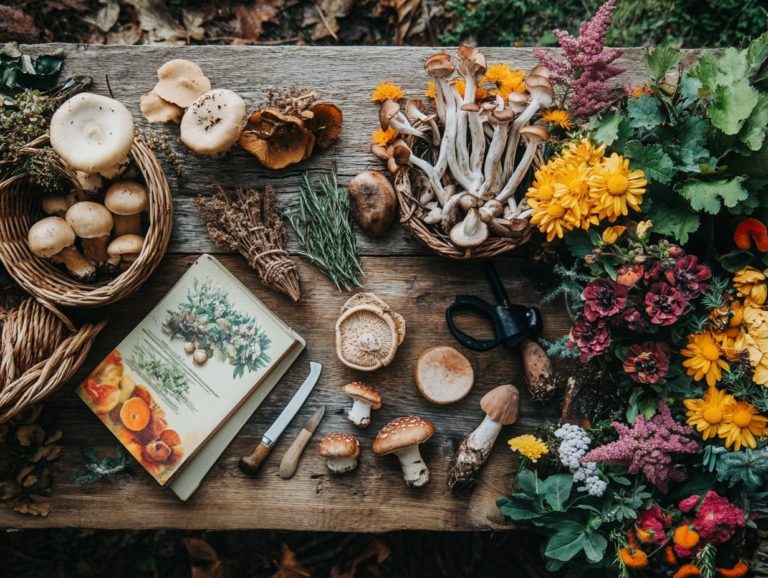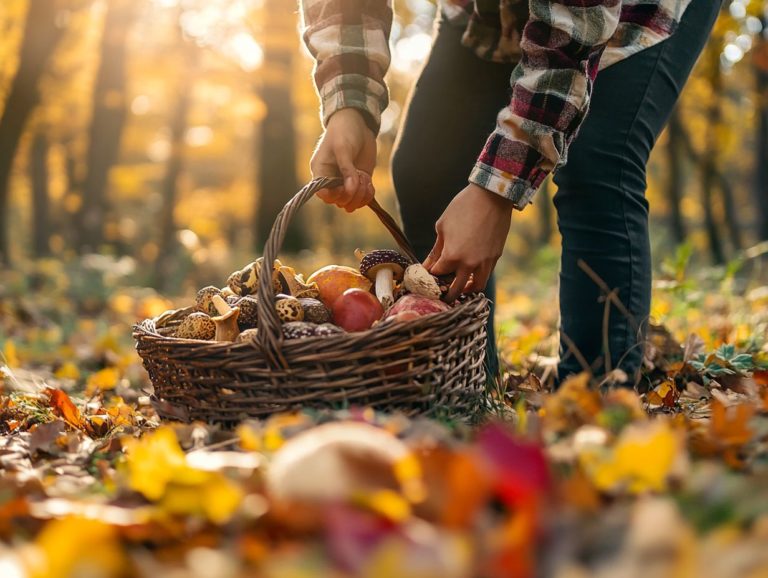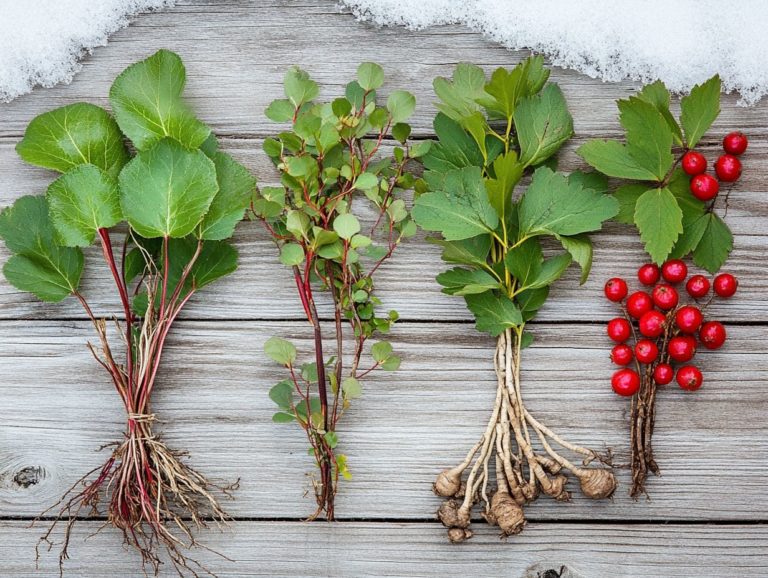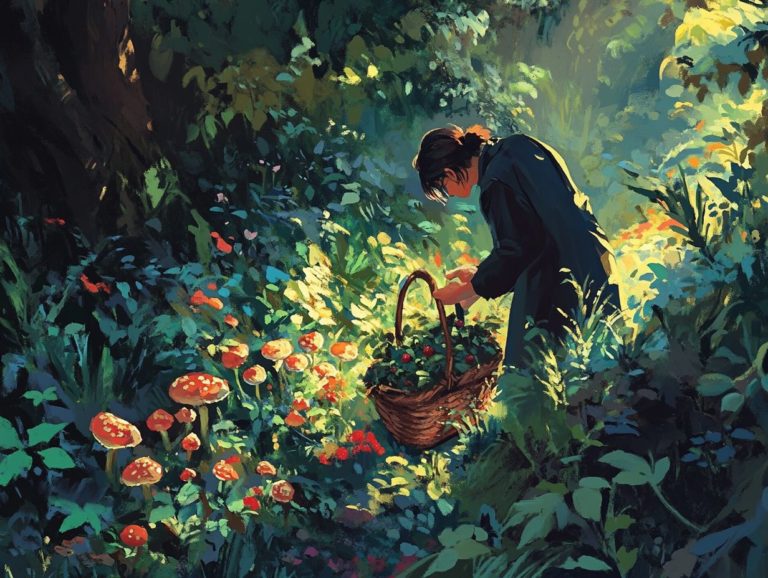10 Seasonal Foraging Myths Debunked
Foraging has emerged as a captivating trend, inviting you to venture into the great outdoors in search of wild edibles. It’s a delightful way to explore the world of food foraging.
Yet, misconceptions are plentiful and often fueled by foraging myths. These can easily dissuade newcomers. You might believe that foraging is strictly for seasoned experts or think all wild mushrooms pose a danger. Such misunderstandings create unnecessary barriers to your exploration.
Let s jump in and uncover the truth behind ten common myths about foraging. We ll emphasize its accessibility, benefits, and the sheer joy it offers to those who wish to connect with nature.
Dive in and discover the truth! Embrace the enriching world of foraging!
Contents
- Here s what you need to know:
- 1. Foraging Is Only for Experienced Hikers or Survivalists
- 2. It Is Illegal to Forage on Public Land
- 3. All Wild Mushrooms Are Poisonous
- 4. Foraging Is Harmful to the Environment
- 5. You Can Only Forage in the Wilderness
- 6. Foraging Is Time-Consuming
- 7. You Need Special Equipment to Forage
- 8. Foraging Is Only for Food
- 9. Wild Plants Are Not Nutritious
- 10. Foraging Is a Solo Activity
- What Is Foraging and Why Is It Gaining Popularity?
- Frequently Asked Questions
Here s what you need to know:

- Foraging is not just for experienced hikers or survivalists; anyone can do it with some basic knowledge and guidance.
- It is usually legal to forage on public land, but check local regulations and obtain permits if necessary.
- While some wild mushrooms are poisonous, there are many edible varieties that can be safely foraged and consumed.
1. Foraging Is Only for Experienced Hikers or Survivalists
Foraging might seem like an adventure reserved for seasoned hikers or survivalists, but it s a practice anyone can dive into. Engaging in foraging enriches your diet with wild plants and high-calorie foods. It also deepens your connection to nature and traditional ecological wisdom.
Community gardens and foraging education courses are fantastic starting points for those eager to learn how to identify edible plants. You can also understand their nutritional composition. By immersing yourself in these environments, you ll gain practical experience and connect with seasoned foragers who can offer invaluable insights.
The resources available on wild edibles are plentiful. They guide newcomers in identifying safe and nutritious plants. Embracing foraging aligns beautifully with the sustainable practices of our hunter-gatherer ancestors, fostering respect for local ecosystems.
Incorporating wild plants into your diet can significantly enhance your cooking skills. It introduces unique flavors and nutrients often absent from conventional foods, ultimately promoting your health and well-being.
2. It Is Illegal to Forage on Public Land
Contrary to popular belief, foraging isn t universally illegal on public land; however, regulations do vary by location. Familiarize yourself with local food policies to practice responsible and sustainable foraging.
Some urban areas have embraced the idea of food forests. These invite residents to harvest fruits, nuts, and edible plants without hesitation. These spaces support biodiversity and enhance community nutrition and food access, especially in food deserts where fresh produce can be hard to come by.
Understanding local laws is crucial, particularly when foraging in parks or conservation areas. Ignorance could lead to fines or other penalties. In cities like Seattle and Portland, community-managed foraging areas illustrate how blending legality with local tradition cultivates a culture that appreciates wild edibles. This ultimately benefits both individuals and the wider community.
3. All Wild Mushrooms Are Poisonous
The notion that all wild mushrooms are poisonous is a perilous myth. In truth, many wild mushrooms are not only safe to eat but also brimming with antioxidants. They can play a vital role in combating chronic diseases when included in a balanced diet.
Take, for instance, delightful varieties like chanterelles, morels, and shiitake mushrooms. These culinary gems offer a rich array of nutrients, including vitamins B and D, fiber, and essential minerals. Incorporating these mushrooms into your meals provides a nutritious alternative to meat, delivering a plant-based source of umami flavor without the saturated fats.
However, foraging for these wild treasures requires a keen understanding of proper identification techniques. Misidentifying species can lead to serious health risks. Being well-versed in their nutritional benefits, including the presence of a type of sugar that can help your immune system, emphasizes the need for education and caution in the art of wild mushroom foraging.
4. Foraging Is Harmful to the Environment
Many believe foraging harms the environment, but this often misses the sustainable practices available. Responsible foraging, guided by the 5 best practices for safe seasonal foraging, can actually help restore ecosystems and support wild food growth.
By following sustainability principles, you can boost biodiversity and nurture healthy ecosystems. This involves respecting the delicate balance of local plants and animals, ensuring you don’t overharvest.
As a forager, you can help protect ecosystems. Use your knowledge from past generations to make informed decisions that promote long-term environmental health.
5. You Can Only Forage in the Wilderness
Foraging isn’t limited to the wilderness. Urban areas are full of opportunities in community gardens and urban food forests.
In these settings, you can find wild plants like dandelion greens and edible flowers to incorporate into your meals. A little knowledge and respect for local rules can connect you with nature and promote sustainability.
Urban foraging boosts food production and community nutrition. It inspires sharing recipes and secret foraging spots.
6. Foraging Is Time-Consuming
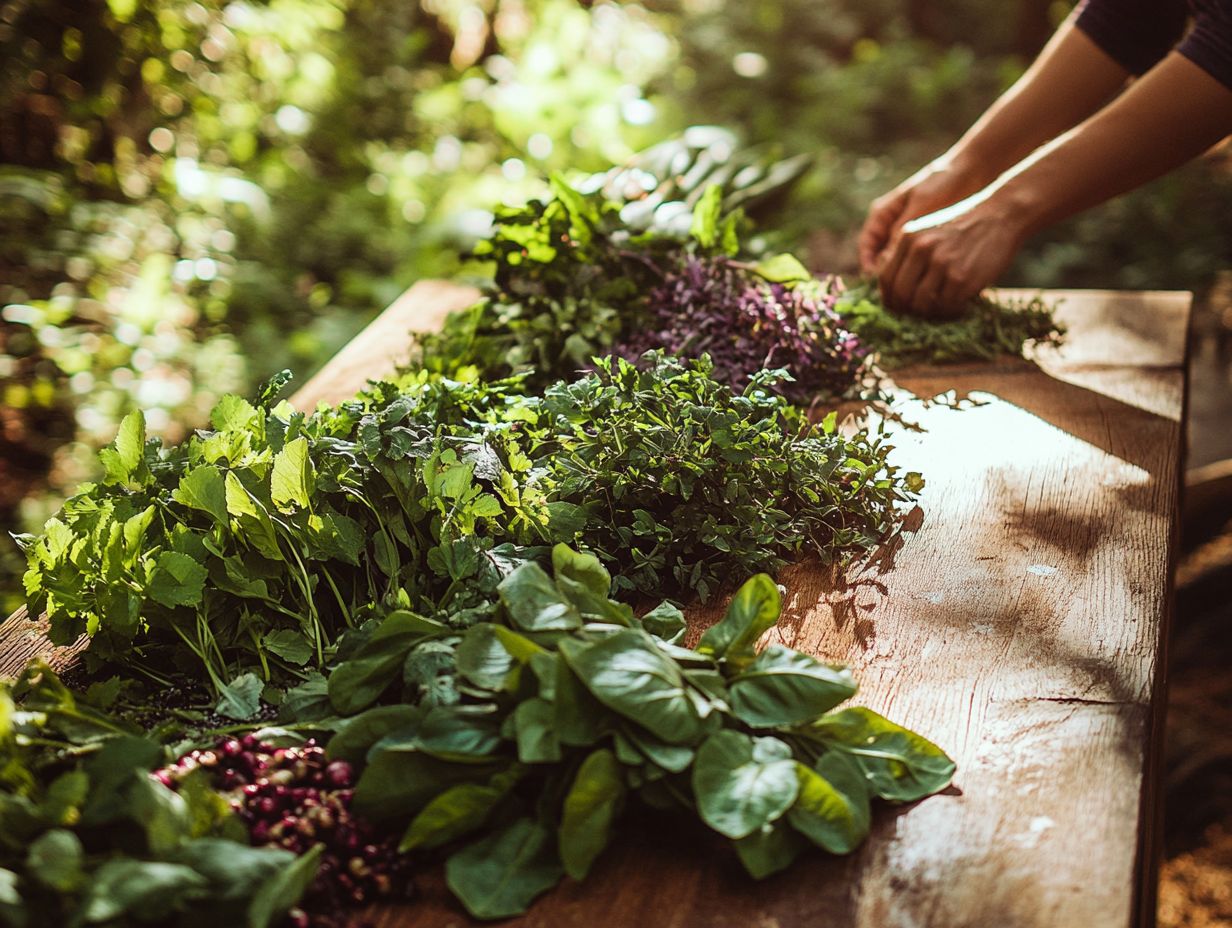
Some see foraging as a daunting task. But with practice, you can gather high-calorie foods without spending a lot of time.
Plan your foraging trips on weekends or during short breaks. This enriching activity can fit seamlessly into your busy life.
Learning about local edible plants will boost your confidence. Use apps and guidebooks to enhance your understanding of safe harvesting.
7. You Need Special Equipment to Forage
Many think foraging requires special tools, but you only need basic items and knowledge of local plants to start. This journey can be rewarding with just a few essentials.
Consider bringing a sturdy basket, a knife for cutting, and a field guide for identifying species. These can often be found at farmers’ markets or borrowed from friends.
Understanding your local ecosystem is key. This helps you identify safe-to-eat plants and promotes sustainable practices.
8. Foraging Is Only for Food
Foraging is often seen simply as a means to gather food, but it s much more than that. It involves collecting a variety of wild plants with medicinal properties and showcases the rich traditional ecological knowledge of this practice.
Engaging in foraging not only diversifies your diet but also reveals the healing powers of herbs and plants cherished for centuries. This practice invites you to reconnect with local ecosystems, deepening your appreciation for biodiversity and the vital roles different species play within it.
Such explorations serve as effective educational opportunities. You can learn about native flora and their uses, enhancing your environmental awareness and sense of stewardship. By immersing yourself in the natural world, you gain insights that go beyond the dinner table, revealing the intricate interconnectedness of life within your community.
9. Wild Plants Are Not Nutritious
Many believe wild plants lack nutrition, but that’s simply not true. In fact, many wild edibles are brimming with nutrient density and natural substances that can greatly enhance your overall health.
Take dandelion greens, for example; they are packed with vitamins A, C, and K, making them a true powerhouse for boosting your immune system and supporting bone health. Similarly, nettles are overflowing with iron and calcium, critical elements for combating anemia and promoting strong bones.
Incorporating these plants into your diet is essential, especially in a world where processed foods often take the spotlight. By embracing such nutrient-rich options, you elevate your nutrient intake and arm your body with tools to combat nutrition-related diseases like obesity and diabetes.
Understanding and using these natural resources fosters healthier eating habits.
10. Foraging Is a Solo Activity
The idea that foraging is purely a solitary pursuit overlooks its vibrant communal essence. Many people come together to forage, enhancing community nutrition and food sovereignty while exchanging knowledge and resources.
Pooling your expertise with others enhances safety allowing participants to identify plants with greater confidence and watch for potential hazards. It also cultivates a spirit of cooperation that reinforces community bonds. Events like urban foraging workshops and community harvest days show how these gatherings transform local landscapes while educating participants about native flora.
These initiatives play a crucial role in urban agriculture by promoting sustainable practices and bolstering local food systems. Ultimately, this collective effort leads to a richer, more resilient community dedicated to ecological stewardship.
What Is Foraging and Why Is It Gaining Popularity?
Foraging is the art of gathering wild food, and it s making a comeback. Many are turning to sustainable, organic options that boost diet diversity and address health issues.
This interest isn’t just a trend; it reflects a desire for nutrition that benefits your body and the planet. With more people seeking local and organic food, the thrill of finding edible treasures in your backyard or nearby woods is more exciting than ever.
Foraging invites you to reconnect with nature, a longing many urban dwellers share. Join your neighbors in sharing tips and recipes! This practice not only enriches your nutrition but also encourages exploration of the ecosystem’s bounty, heightening awareness of sustainable food systems and the vital importance of biodiversity.
What Are the Benefits of Foraging?
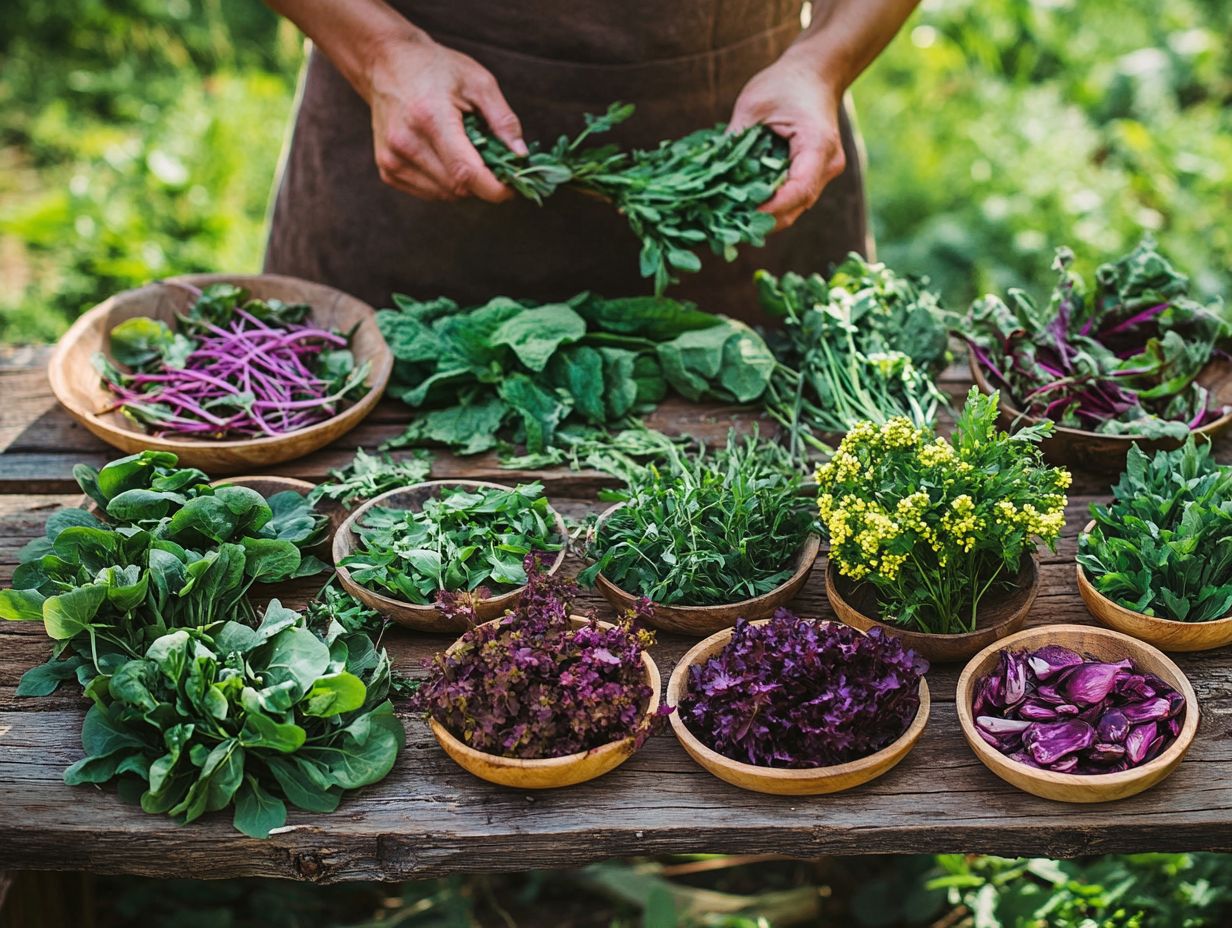
Unlock the amazing benefits of foraging! Discover how gathering healthy wild plants can boost your diet and overall wellness.
Foraging gives you access to a diverse array of healthy wild plants. These can elevate your diet and provide a sustainable source of nourishment, positively influencing your overall health.
By incorporating these wild edibles into your meals, you can boost your intake of essential vitamins, minerals, and antioxidants critical components for maintaining optimal health. These foraged foods are typically low in calories and high in fiber, making them excellent allies for weight management and reducing your risk of chronic diseases such as heart disease and diabetes.
Engaging in foraging deepens your connection to nature, fostering environmental stewardship. You ll raise awareness about sustainable practices and become part of the conservation effort, ensuring that these invaluable resources continue to flourish for generations to come.
How Can One Safely Forage for Wild Foods?
Start your foraging adventure by using trusted field guides and apps for plant identification. Safely foraging for wild foods demands a solid grasp of local wild food sources and skills in proper identification techniques.
Understanding the rules about labeling food can help you sidestep the risks tied to consuming toxic plants. Equally crucial is familiarizing yourself with local regulations, as some areas impose restrictions on foraging to protect native ecosystems.
Joining local workshops and foraging groups can provide invaluable hands-on experience and expert guidance.
Be mindful of organic farming practices to ensure your foraged ingredients are clean. This approach fosters a healthier and more sustainable way to enjoy wild harvesting.
What Are the Best Seasons for Foraging?
Knowing the best seasons for foraging helps you gather the healthiest wild plants! Different species peak at specific times of the year, enriching your diet s nutritional composition.
In spring, vibrant greens like wild garlic and nettles burst forth, delivering a refreshing wave of nutrients after those long winter months. Summer brings luscious berries such as blackberries and raspberries in abundance, offering delightful flavor and a wealth of antioxidants.
When autumn rolls around, hearty mushrooms like chanterelles and porcini await. They serve as fantastic sources of umami the savory taste that enhances your dishes adding depth to your culinary creations.
Winter, on the other hand, invites you to forage for roots and tubers, allowing you to tap into the earth s reserves. Embrace this seasonal knowledge to enhance your personal food system, craft diverse meals, and cultivate a deeper connection to your local ecosystems.
What Are Some Common Edible Plants and Mushrooms to Forage?
Common edible plants and mushrooms, like dandelions, wild garlic, and chanterelles, present a delightful array of dietary options that are both tasty and nutritious.
Nettles, brimming with vitamins A and C, can be seamlessly incorporated into soups or teas. Morels are culinary treasures with a unique flavor that elevate gourmet dishes to new heights.
By weaving these diverse ingredients into your meals, you can enhance both flavor and nutrition. However, foraging for these plants and fungi requires a keen understanding of their habitats and characteristics.
Educating yourself about foraging is essential, as it gives you the power to distinguish between safe and toxic species. This knowledge ensures that your sustainable foraging practice enriches your diet and fosters a deeper connection with nature.
How Can One Incorporate Foraged Foods into Their Diet?
Adding foraged foods to your diet makes it more diverse and supports a transition toward more organic and locally sourced ingredients. This can ultimately improve your overall health and well-being.
By exploring the vast array of edible plants in your local environment, you can uncover unique flavors that elevate your everyday meals. Simple practices, like blending wild greens into a vibrant salad or using foraged mushrooms to create a rich, earthy pasta dish, allow for a delightful fusion with conventional ingredients.
You can also preserve foraged foods through techniques like drying or pickling. This ensures you can savor their goodness long after the season has passed. This approach not only helps the environment but also connects you with nature, encouraging a lifestyle that values your health.
Frequently Asked Questions
What are some common myths about seasonal foraging?
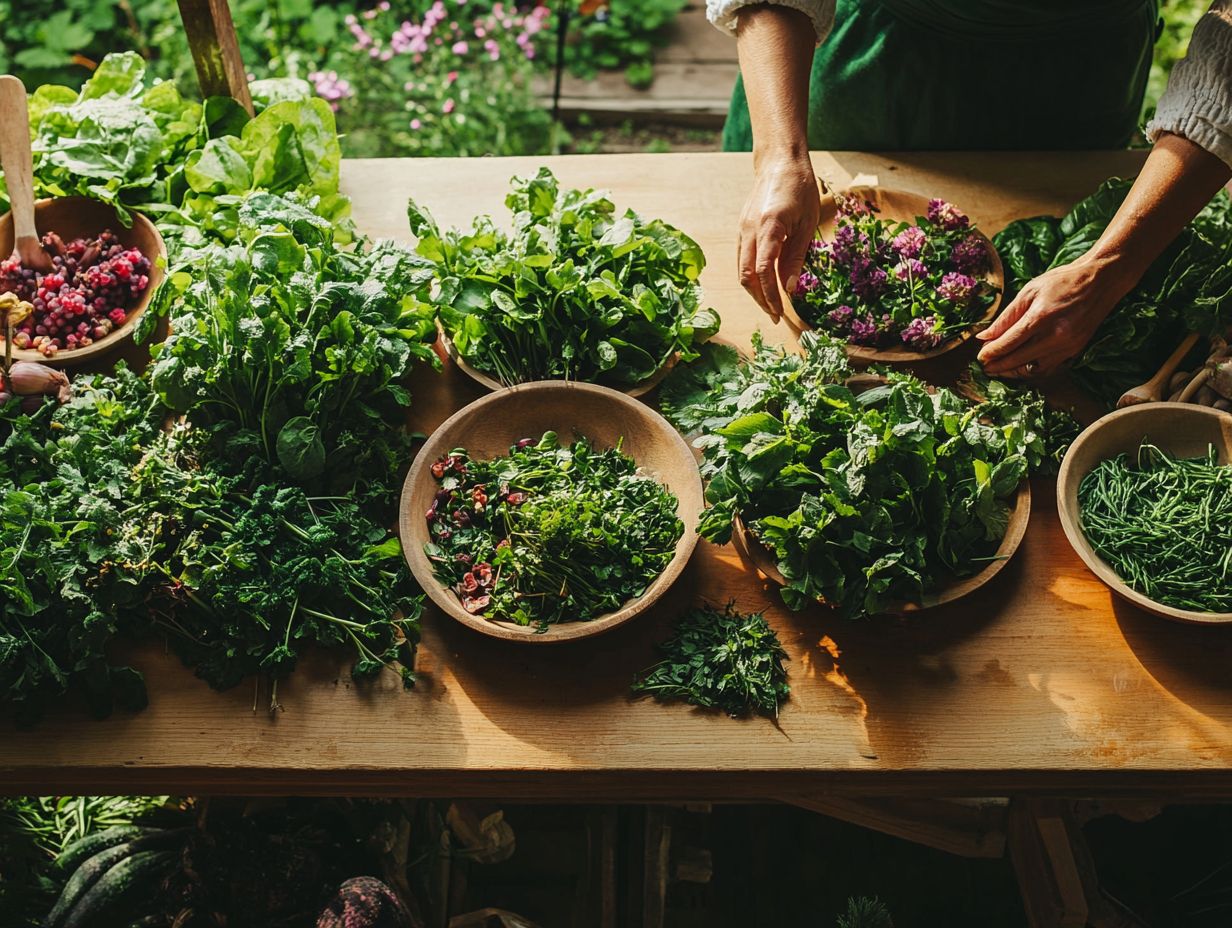
Some myths about seasonal foraging include the belief that all wild berries are safe to eat, that you can eat any mushroom you find in the woods, and that all plants with red leaves are poisonous. For a deeper understanding, check out common myths about foraging.
Is it true that you can eat any wild mushroom?
No, this is a common misconception. While some wild mushrooms are edible and prized delicacies, others can be toxic or even deadly. Always ensure you know what you’re eating by properly identifying and researching any wild mushroom before consuming it.
Are all wild berries safe to eat?
No, not all wild berries are safe to eat. Some can be poisonous or cause allergic reactions. Properly identifying any wild berries before consumption is crucial.
Can I forage for food in any season?
While some foods can be foraged year-round, others are only available during specific seasons. Research which foods are in season in your area before foraging.
Is it safe to eat plants with red leaves?
No, not all plants with red leaves are safe to eat. Some, like poison sumac, are toxic and can cause harm if ingested. Properly identifying any plants before consuming them is essential.
Can I forage in any location?
Foraging is rooted in traditional ecological knowledge, often employed by hunter-gatherers and increasingly embraced in urban agriculture through community gardens and food foraging initiatives. It is important to have permission from the landowner before foraging on any private property.
Foraging on public lands may also require a permit or specific regulations. Research and follow the rules and regulations of the area you plan to forage in.
Ready to explore the wild flavors around you? Let s dive into foraging!

![The Best Locations for Winter Foraging in [Your Area]](https://forageadept.com/wp-content/uploads/2024/08/the-best-locations-for-winter-foraging-in-your-area-jI-768x578.jpeg)
![Top 5 Foraging Locations in [Your Area] This Winter](https://forageadept.com/wp-content/uploads/2024/08/top-5-foraging-locations-in-your-area-this-winter-7a-768x578.jpeg)
